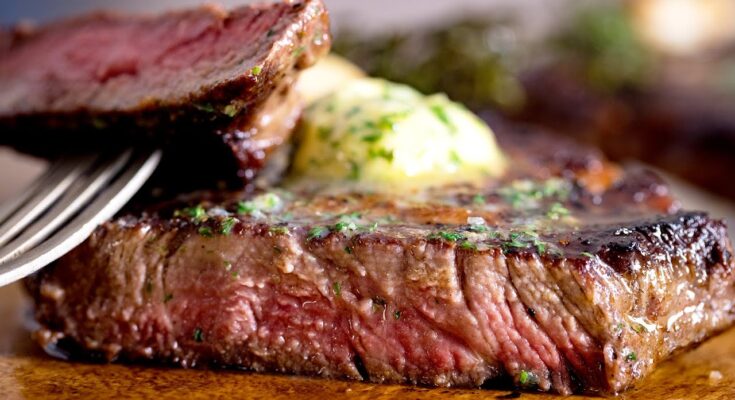Sirloin Steak Recipe: Few dishes scream elegance and flavor quite like a perfectly cooked sirloin steak. Whether you’re planning a romantic dinner, impressing guests, or simply treating yourself, this juicy, tender, and flavorful cut of beef never disappoints.
In this guide, we’ll take you through the entire process of cooking sirloin steak—from preparation to serving—with tips and tricks to ensure perfect results every time.
Why is sirloin steak so popular?
Sirloin comes from the rear back portion of the cow, offering a lean yet flavorful meat profile. Its balance between tenderness and affordability makes it a favorite for home cooks and professional chefs alike.
Nutritional Benefits of Sirloin Steak:
- Protein-Packed: Each serving provides high-quality protein for muscle growth and repair.
- Low in Fat: Sirloin is relatively lean compared to ribeye or T-bone, making it a healthier option.
- Rich in Vitamins: It is loaded with essential nutrients like B12, zinc, and iron, boosting energy levels and immune health.
Types of Sirloin Steaks
Sirloin steak is a versatile cut of beef taken from the back of the cow, near the loin. It’s prized for its balance of tenderness and flavor, making it ideal for grilling, pan-searing, or broiling.
- Top Sirloin – Leaner and more tender, perfect for grilling.
- Bottom Sirloin – Slightly tougher but richer in flavor, often used for roasting.
Why Choose Sirloin?
- Affordable yet flavorful. Sirloin offers a great balance between cost and quality.
- Easy to cook. Its thickness and texture make it adaptable to various cooking methods.
- Healthy option. Sirloin is lean and protein-rich, perfect for a balanced diet.
Ingredients for Sirloin Steak
- 1–2 sirloin steaks (8–10 oz each)
- Salt (preferably sea salt or kosher salt)
- Freshly ground black pepper
- 1–2 tablespoons olive oil or avocado oil
- 2 tablespoons unsalted butter
- 3–4 garlic cloves (crushed)
- Fresh herbs (rosemary or thyme)
Optional:
- Red chili flakes for spice
- Lemon wedges for serving
Tools and Equipment Needed
- Cast-iron skillet or grill pan
- Tongs for flipping the steak
- Meat thermometer
- Cutting board
- Sharp knife
- Aluminum foil for resting
Step 1: Preparing the Steak
Thawing and Bringing to Room Temperature
- Remove the steak from the refrigerator at least 30-45 minutes before cooking.
- Pat it dry with paper towels to remove excess moisture—this helps in achieving a perfect sear.
Seasoning the Steak
- Generously season both sides with salt and pepper.
- For added flavor, rub in garlic powder, paprika, or your preferred spice mix.
- Lightly coat with olive oil to ensure an even crust when searing.
Step 2: Preheating and Preparing the Pan or Grill
Choosing the Right Cooking Surface
- Use a cast-iron skillet for the best heat retention.
- Alternatively, a grill pan or outdoor grill works perfectly for grill marks.
Adding Oil and Preheating
- Heat the pan over medium-high heat until it starts smoking slightly.
- Add olive oil and spread it evenly before placing the steak in the pan.
Step 3: Cooking the Steak
Searing for Maximum Flavor
- Place the steak in the hot pan and sear for 2-3 minutes per side without moving it.
- Add butter, garlic, and fresh herbs to the pan after flipping the steak.
- Use a spoon to continuously baste the steak with melted butter and garlic.
Determining Doneness Levels
- Rare (120–125°F) – Cool red center.
- Medium Rare (130–135°F) – Warm red center.
- Medium (140–145°F) – Slightly pink center.
- Medium Well (150–155°F) – Faint pink center.
- Well Done (160°F and above) – Fully cooked, no pink.
Use a meat thermometer for accuracy, and avoid cutting into the steak to check doneness.
Step 4: Resting the Steak
Why Resting is Crucial
Resting the steak allows the juices to redistribute, ensuring each bite is moist and flavorful.
- Transfer the steak to a cutting board and loosely cover it with foil.
- Let it rest for 5–10 minutes before slicing.
Step 5: Serving the Steak
Slicing Tips
- Slice against the grain for maximum tenderness.
- Use a sharp knife to create clean, even slices.
Pairing Suggestions
- Vegetables: Grilled asparagus, roasted potatoes, or sautéed spinach.
- Sauces: Peppercorn sauce, chimichurri, or garlic butter.
- Drinks: Red wines like Cabernet Sauvignon or Merlot complement sirloin beautifully.
Variations of Sirloin Steak Recipes
Garlic Butter Sirloin Steak
For an extra burst of flavor, try a garlic butter finish:
- Melt 2 tablespoons of butter in the pan during the final minute of cooking.
- Add minced garlic and fresh parsley for a rich, aromatic taste.
- Baste the steak with the melted butter mixture before serving.
Spicy Cajun Sirloin
If you love bold flavors, spice things up:
- Coat the steak with a Cajun spice rub before cooking.
- Add a sprinkle of red chili flakes and smoked paprika for extra heat.
- Serve with a cooling yogurt dip or blue cheese dressing.
Asian-Inspired Sirloin
For an exotic twist:
- Marinate the steak in a mix of soy sauce, sesame oil, garlic, ginger, and honey for 1 hour.
- Sear as usual and garnish with sesame seeds and green onions before serving.
Common Mistakes to Avoid When Cooking Sirloin Steak
1. Skipping the Resting Time
Cutting into the steak immediately after cooking causes juices to escape, resulting in a dry steak. Always let it rest for at least 5–10 minutes.
2. Not Using a Meat Thermometer
Guessing the doneness can lead to overcooked or undercooked steak. Use a thermometer for precision.
3. Overcrowding the Pan
Cooking multiple steaks in a small pan reduces heat, preventing a proper sear. Cook one or two steaks at a time.
4. Using Cold Meat
Cooking steak straight from the refrigerator can lead to uneven cooking. Always bring the steak to room temperature before cooking.
5. Overseasoning
While seasonings enhance flavor, adding too much salt or spice can overpower the steak’s natural taste. Stick to simple seasonings like salt, pepper, and garlic.
Tips for Cooking the Perfect Sirloin Steak
- Choose High-Quality Meat – Look for grass-fed beef with good marbling for the best flavor and texture.
- Pat It Dry – Moisture on the surface prevents browning, so always pat your steak dry before seasoning.
- Use High Heat – Preheat your pan or grill to medium-high heat for the perfect sear.
- Don’t Overcook – Sirloin steak tastes best at medium-rare or medium for a juicy interior.
- Baste with Butter – Adding butter during cooking enhances flavor and prevents drying out.
- Experiment with Marinades – Marinades like soy sauce, balsamic vinegar, and garlic can tenderize the meat and add depth to the flavor.
Nutritional Information
| Nutrient | Amount Per Serving (8 oz) |
|---|---|
| Calories | 450 |
| Protein | 50g |
| Fat | 28g |
| Saturated Fat | 11g |
| Cholesterol | 110mg |
| Sodium | 75mg |
| Iron | 15% Daily Value |
Note: Nutritional values may vary depending on the cut and cooking method used.
How to Store Leftover Sirloin Steak
Refrigerating
- Wrap the steak tightly in plastic wrap or foil and store it in an airtight container.
- Consume within 3–4 days for optimal freshness.
Freezing
- Place steak in a vacuum-sealed bag or freezer-safe container.
- Freeze for up to 3 months.
Reheating Tips
- Avoid microwaving, as it can dry out the steak.
- Instead, reheat in a skillet over low heat or in the oven at 275°F until warm.
FAQs about Sirloin Steak Recipe
1. What is the best way to cook sirloin steak?
To achieve the best results, sirloin steak should be cooked using high-heat methods such as grilling, broiling, or pan-searing. Preheat your cooking surface to ensure it’s hot enough to sear the steak, locking in those delicious juices.
2. How long should I cook a sirloin steak?
The cooking time for sirloin steak depends on your desired level of doneness. For a medium-rare steak, cook each side for approximately 4-5 minutes on high heat. Adjust the time if you prefer your steak more or less done.
3. Should I marinate sirloin steak?
While sirloin is flavorful enough on its own, marinating can add more depth of flavor and tenderize the meat. A simple marinade using ingredients like olive oil, garlic, and herbs works well and should be applied several hours before cooking.
4. What temperature should sirloin steak reach when it’s done?
For medium-rare, aim for an internal temperature of 130-135°F (54-57°C). Always use a meat thermometer to check. If you prefer medium, cook until it reaches 140-145°F (60-63°C).
5. Can I cook sirloin steak in the oven?
Yes, sirloin steak can be finished in the oven after searing it on the stove. This method is great for thicker cuts, ensuring they cook evenly without burning the exterior. Preheat your oven to 375°F (190°C) and cook to your desired doneness.
6. What are some good side dishes to serve with sirloin steak?
Classic sides like mashed potatoes, sautéed vegetables, or a fresh salad pair wonderfully with sirloin steak. For a low-carb option, consider roasted cauliflower or a kale salad.
Conclusion
Cooking the perfect sirloin steak doesn’t have to be intimidating. By following this step-by-step guide, you can achieve restaurant-quality results in the comfort of your kitchen. From seasoning and searing to resting and slicing, each step plays a vital role in delivering a juicy, flavorful steak. Whether you prefer a simple salt-and-pepper rub or an adventurous marinade, sirloin steak is versatile enough to match any taste preference.
So, grab your ingredients, fire up the skillet, and get ready to enjoy one of the most delicious and satisfying meals you can make at home.



